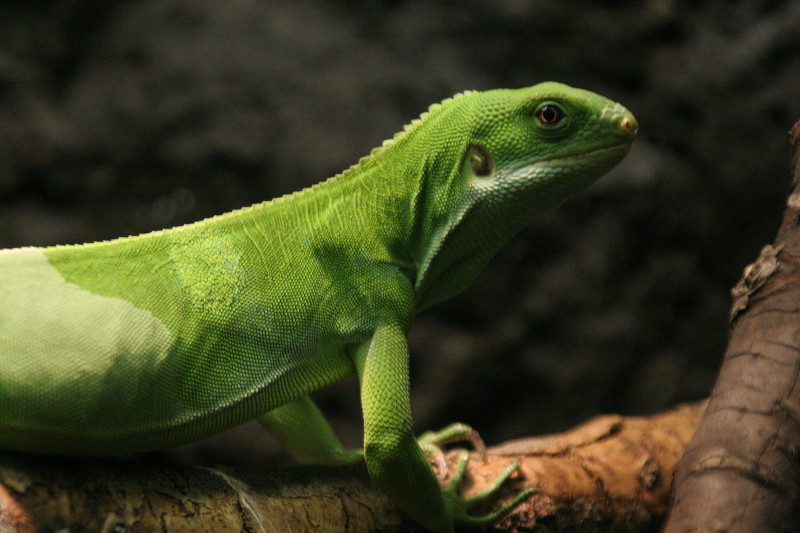Lau Banded Iguana Facts
- The descriptive term of Lau Banded Iguana serves as the common name for an intriguing species of reptile. For the moment, this remarkable product of evolution has no other generally accepted name. It’s also often confused with similar local species.
- The majority of professionals, however, such as researchers, typically refer to it by its formal name. Like most such monikers, though, it’s hard for the layman to pronounce. That’s because the animal bears the technical name of Brachylophus fasciatus.
- The creature received that official name due to the efforts of the noted French zoologist, Alexandre Brongniart. He accomplished the first acknowledgement of it as a separate and distinct species. This scientifically noteworthy event occurred in 1800.
- Unfortunately, however, this creation of Nature appears to be steadily dwindling in numbers in the wild. Its current zone of habitation measures much smaller than in the past. It’s also present in a neighboring region, though only as an introduced species.
- Due to a combination of factors, the IUCN currently lists the Lau Banded Iguana as Endangered. That status appears on the organization’s published Red List of Threatened Species. The near future could see its status worsen even further, though.
- The reptile faces several threats to its existence. Its most immediate threats include habitat loss due to human activities, such as agricultural practices, as well as danger from introduced species. Long term, however, its greatest threat, is climate change.
Related Articles
Lau Banded Iguana Physical Description
The beautiful Lau Banded Iguana easily captivates those fortunate enough to encounter it in the wild. It also does so for various reasons. Sheer physical size, however, isn’t among them. That’s true since the animal ranks as approximately average-sized among its kindred.
Like many of those related species, it also displays a moderate degree of the physiological trait of sexual dimorphism. In its specific case, however, this trait manifests itself in terms of appearance, instead of size. Adults of both sexes thus attain roughly the same physical size.
That includes an average length, including body and tail, of 24 in (60 cm). Its weight further averages about 0.44 lb (0.2 kg). Each also has a comparatively small crest running down the back of its head and spine. This specific feature, however, only averages 0.2 in (0.5 cm).
It’s in terms of appearance, though, that the genders of the reptile differ. That’s because males display several pale white bands that cross their background colors. These markings average roughly 0.8 in (2 cm) in width. Each of the males shows either 2 or 3 of these.
Otherwise, the appearance of both genders of the Lau Banded Iguana remains the same. That principally consists of an emerald green background shade. Small, off-white spots or streaks also develop on the neck. Males, though, typically display more of each marking.
Among females, these spots additionally tend to develop in fewer numbers. The underside of both males and females, however, presents the same color scheme. That consists of a light yellow. All individuals also have the ability to modify their color at will, for camouflage.
- Kingdom: Animalia
- Phylum: Chordata
- Class: Reptilia
- Order: Squamata
- Family: Iguanidae
- Genus: Brachylophus
- Species: B. fasciatus
Lau Banded Iguana Distribution, Habitat, and Ecology
Regrettably, the amazing Lau Banded Iguana possesses a highly restricted zone of habitation. Evidence does indicate, however, that the iguana once existed across a somewhat greater range. Even at the time of its greatest dispersal, though, it never lived across a vast range.
That’s due to the fact that it previously inhabited a full group of islands, the Lau Islands. These in turn lie within the greater group forming the island country of Fiji. Now, however, its population seems to be restricted to only eleven islands within the smaller group.
Even inside of that limited range, though, it evolved to prefer a specific type of environment. Due to that preference, it most frequently appears in regions of wet forest. Smaller concentrations do also make their home in forests with slightly lower moisture levels.
For reasons still not completely understood, the animal also displays a marked preference for certain altitudes. On all islands it lives on within its territory, the vast majority of individuals live at alttitudes ranging from 656 – 1,640 ft ( 200 – 500 m) above sea level.
It also requires the presence of numerous trees, thus its favoring forested regions. There, it lives as a primarily arboreal species. It also evolved as diurnal in nature. At night, individuals retreat to the shelter of the trees. This provides a measure of protection from predators.
By day, the Lau Banded Iguana descends to the forest floor. There it forages throughout its range, as a herbivore. The reptile feeds on a variety of local plants, typically consisting of the flowers, fruit, and leaves. It’s especially fond of papayas, bananas, and hibiscus flowers.
Species Sharing Its Range
Check out our other articles on 5 Mesmerizing Marvels of Italy, Swamp Dacrydium, Grand Prismatic Spring, Gray Fox, African Monarch, Wilson’s Bird-of-paradise, Hermann’s Tortoise

